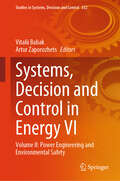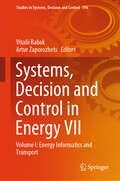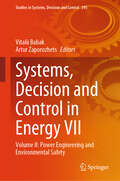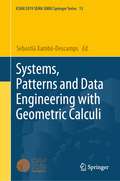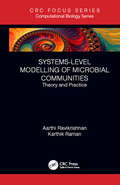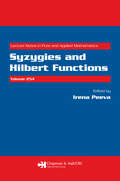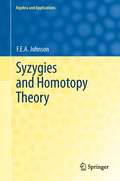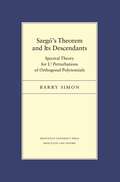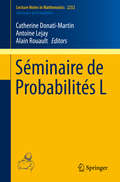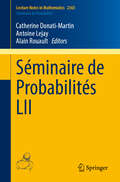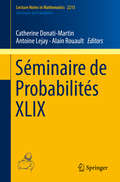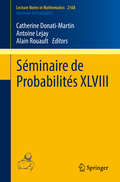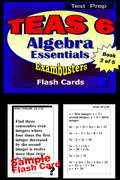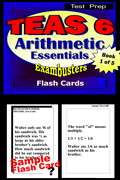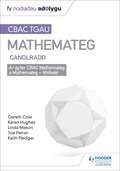- Table View
- List View
Systems, Decision and Control in Energy VI: Volume II: Power Engineering and Environmental Safety (Studies in Systems, Decision and Control #552)
by Artur Zaporozhets Vitalii BabakThis book presents the defining hallmark of 2023's energy panorama which lies in the resounding impetus toward sustainability—a seismic paradigm shift echoing across industries, policies, and societal aspirations. Heightened awareness of climate change, environmental degradation, and the imperatives of decarbonization propel an unprecedented surge toward renewable energy alternatives. Solar, wind, hydro, geothermal, and other sustainable modalities witness not only technological advancements but a transformative surge in accessibility, affordability, and scalability, redefining the global energy matrix. Within this transformative landscape, innovation emerges as the fulcrum catalyzing the metamorphosis of energy systems. Breakthroughs in energy storage technologies, smart grid optimization, and decentralized energy solutions orchestrate a symphony of efficiency, enabling the seamless integration of intermittent renewable sources while ensuring grid stability and resilience. The amalgamation of artificial intelligence, big data analytics, and energy systems heralds a new frontier of smart, adaptive energy networks, revolutionizing the paradigm of energy consumption and management. Furthermore, the geopolitical milieu assumes heightened significance in shaping the contours of global energy dynamics. Interwoven with alliances, trade dynamics, and international agreements, geopolitics exerts profound influences on energy security, infrastructural investments, and the trajectory of sustainable energy transitions. Collaborative endeavors and multilateral initiatives reverberate as essential instruments in navigating the complexities of a globally interconnected energy landscape. However, amid the triumphant strides toward a sustainable energy future, challenges persist. The intricacies of phasing out legacy infrastructures, addressing socio-economic disparities, navigating policy ambiguities, and fostering inclusive energy transitions underscore the labyrinthine complexities that necessitate astute navigation and multifaceted solutions.
Systems, Decision and Control in Energy VII: Volume I: Energy Informatics and Transport (Studies in Systems, Decision and Control #596)
by Artur Zaporozhets Vitalii BabakThis book presents a curated selection of contemporary research, capturing the progress of Ukrainian and international scientists in addressing the complex issues surrounding energy systems, sustainable fuels, and efficient transport solutions. The world&’s growing energy demands, coupled with pressing environmental concerns, present significant challenges and opportunities in the energy sector. The advancements within this sector are increasingly driven by innovations in technology, information systems, and cross-disciplinary research efforts. Through this collaborative scientific endeavor, the authors aim to offer a holistic view of current advancements and innovative solutions in three core areas: energy informatics, fuels, and transport. Energy informatics integrates data analytics, digital infrastructure, and real-time monitoring to improve energy efficiency and support sustainable energy transitions. The works presented in this section illustrate how the integration of cutting-edge computational models, artificial intelligence, and big data analytics is enabling smarter, more adaptive energy systems. Topics covered include optimization of energy consumption, predictive modeling for energy needs, and the development of robust frameworks to manage and process vast amounts of energy-related data. This section highlights how energy informatics serves as a foundational tool in meeting the evolving demands for efficient and sustainable energy. In the fuels section, the book addresses the urgent need for alternative and cleaner energy sources. The global push toward reducing greenhouse gas emissions and mitigating climate change impacts has accelerated research into innovative fuel sources. This section underscores the critical role of novel fuel technologies in ensuring energy security and reducing environmental impact. Transport, the third section, encompasses research on the transformation of the transport sector toward sustainability and efficiency. Transportation is a major consumer of energy and a significant source of emissions, making it a focal area in the transition to cleaner energy systems. This section presents a variety of studies on electric mobility and the development of low-emission technologies.
Systems, Decision and Control in Energy VII: Volume II: Power Engineering and Environmental Safety (Studies in Systems, Decision and Control #595)
by Artur Zaporozhets Vitalii BabakThis book explores the intricate interplay between burgeoning energy demands and the imperatives of ecological sustainability. The first section, Electric Power Engineering, explores critical innovations in the generation, transmission, and distribution of electric power. As global energy demands rise, the development of efficient and reliable electric power systems becomes essential. This section includes studies on optimizing grid performance, enhancing resilience, and integrating smart grid technologies. Advances in grid automation, energy storage, and demand response are examined, reflecting the shift toward adaptive, efficient, and secure power systems. The second section, Heat Power Engineering, addresses innovations in the generation and distribution of thermal energy. Heat power plays a vital role in industrial processes, residential heating, and energy-intensive applications, particularly in regions with cold climates. Researchers in this section present work on the optimization of heat transfer systems, combined heat and power (CHP) technologies, and efficient thermal energy storage solutions. The third section, Renewable Power Engineering, focuses on the development and integration of sustainable energy sources. Renewable energy technologies, such as wind, solar, hydro, and biomass, have become critical in reducing carbon emissions and achieving energy independence. The contributions in this section highlight advances in renewable energy production, storage, and integration with existing power systems. The final section, Environmental Safety, encompasses research on mitigating the environmental impact of energy production and consumption. With energy systems being one of the primary sources of emissions and pollution, environmental safety has become a central concern in energy research. This section presents studies on emission reduction technologies, pollution control strategies, and sustainable waste management practices within the energy sector. It includes research on air and water quality and sustainable resource utilization, highlighting how environmental safety measures can be incorporated into all stages of energy production and distribution.
Systems, Patterns and Data Engineering with Geometric Calculi (SEMA SIMAI Springer Series #13)
by Sebastià Xambó-DescampsThe intention of this collection agrees with the purposes of the homonymous mini-symposium (MS) at ICIAM-2019, which were to overview the essentials of geometric calculus (GC) formalism, to report on state-of-the-art applications showcasing its advantages and to explore the bearing of GC in novel approaches to deep learning. The first three contributions, which correspond to lectures at the MS, offer perspectives on recent advances in the application GC in the areas of robotics, molecular geometry, and medical imaging. The next three, especially invited, hone the expressiveness of GC in orientation measurements under different metrics, the treatment of contact elements, and the investigation of efficient computational methodologies. The last two, which also correspond to lectures at the MS, deal with two aspects of deep learning: a presentation of a concrete quaternionic convolutional neural network layer for image classification that features contrast invariance and a general overview of automatic learning aimed at steering the development of neural networks whose units process elements of a suitable algebra, such as a geometric algebra. The book fits, broadly speaking, within the realm of mathematical engineering, and consequently, it is intended for a wide spectrum of research profiles. In particular, it should bring inspiration and guidance to those looking for materials and problems that bridge GC with applications of great current interest, including the auspicious field of GC-based deep neural networks.
Systems-Level Modelling of Microbial Communities: Theory and Practice (Focus Computational Biology Series)
by Karthik Raman Aarthi RavikrishnanSystems-Level Modelling of Microbial Communities: Theory and Practice introduces various aspects of modelling microbial communities and presents a detailed overview of the computational methods which have been developed in this area. This book is aimed at researchers in the field of computational/systems biology as well as biologists/experimentalists studying microbial communities, who are keen on embracing the concepts of computational modelling. The primary focus of this book is on methods for modelling interactions between micro-organisms in a community, with special emphasis on constraint-based and network-based modelling techniques. A brief overview of population- and agent-based modelling is also presented. Lastly, it covers the experimental methods to understand microbial communities, and provides an outlook on how the field may evolve in the coming years.
Systemverfahrenstechnik in der Ingenieurspraxis: Beherrschung von Prozessen, Gefährdungen und Reinheitskriterien
by Bernd EbertDas Buch behandelt die für das Optimum verfahrenstechnischer Prozesse unerlässliche System-Betrachtung. Diese sollte nicht nur für den „reinen“ Prozess erfolgen, sondern für den gesamten Lebenszyklus technischer Anlagen – vom Entwurf eines Prozesses bis zur Optimierung im laufenden Betrieb. Dabei kommt es nicht nur auf den Normalbetrieb an (wie häufig bei Simulationen betrachtet), sondern auch auf An- und Abfahrprozesse, das Havarie-/Störungsverhalten der Prozesse, die Reinigungsabläufe, Sicherheitsmaßnahmen usw. Geeignete Analyse- und Betrachtungsmethoden werden dazu vorgestellt, die sich in langjähriger Planungs- und Betriebspraxis herausgebildet haben. Hierzu zählen u.a. Risikoanalysen, Zeitdynamik- und Zuverlässigkeitsmethoden; deren theoretischer Ansatz wird mit ihrer praktischen Anwendbarkeit verbunden. Auch Aspekte wie Industrie 4.0 und Prozessänderungen bei laufenden Anlagen werden betrachtet. Damit soll ein Beitrag sowohl für die Ingenieurausbildung, die technische Betriebsbetreuung als auch für die Projektabwicklung geleistet werden.
Syzygies and Hilbert Functions (Lecture Notes in Pure and Applied Mathematics)
by Irena PeevaHilbert functions and resolutions are both central objects in commutative algebra and fruitful tools in the fields of algebraic geometry, combinatorics, commutative algebra, and computational algebra. Spurred by recent research in this area, Syzygies and Hilbert Functions explores fresh developments in the field as well as fundamental concepts.
Syzygies and Homotopy Theory
by F.E.A. JohnsonThe most important invariant of a topological space is its fundamental group. When this is trivial, the resulting homotopy theory is well researched and familiar. In the general case, however, homotopy theory over nontrivial fundamental groups is much more problematic and far less well understood. Syzygies and Homotopy Theory explores the problem of nonsimply connected homotopy in the first nontrivial cases and presents, for the first time, a systematic rehabilitation of Hilbert's method of syzygies in the context of non-simply connected homotopy theory. The first part of the book is theoretical, formulated to allow a general finitely presented group as a fundamental group. The innovation here is to regard syzygies as stable modules rather than minimal modules. Inevitably this forces a reconsideration of the problems of noncancellation; these are confronted in the second, practical, part of the book. In particular, the second part of the book considers how the theory works out in detail for the specific examples Fn ´F where Fn is a free group of rank n and F is finite. Another innovation is to parametrize the first syzygy in terms of the more familiar class of stably free modules. Furthermore, detailed description of these stably free modules is effected by a suitable modification of the method of Milnor squares. The theory developed within this book has potential applications in various branches of algebra, including homological algebra, ring theory and K-theory. Syzygies and Homotopy Theory will be of interest to researchers and also to graduate students with a background in algebra and algebraic topology.
Szegő's Theorem and Its Descendants: Spectral Theory for L2 Perturbations of Orthogonal Polynomials (Porter Lectures #6)
by Barry SimonThis book presents a comprehensive overview of the sum rule approach to spectral analysis of orthogonal polynomials, which derives from Gábor Szego's classic 1915 theorem and its 1920 extension. Barry Simon emphasizes necessary and sufficient conditions, and provides mathematical background that until now has been available only in journals. Topics include background from the theory of meromorphic functions on hyperelliptic surfaces and the study of covering maps of the Riemann sphere with a finite number of slits removed. This allows for the first book-length treatment of orthogonal polynomials for measures supported on a finite number of intervals on the real line. In addition to the Szego and Killip-Simon theorems for orthogonal polynomials on the unit circle (OPUC) and orthogonal polynomials on the real line (OPRL), Simon covers Toda lattices, the moment problem, and Jacobi operators on the Bethe lattice. Recent work on applications of universality of the CD kernel to obtain detailed asymptotics on the fine structure of the zeros is also included. The book places special emphasis on OPRL, which makes it the essential companion volume to the author's earlier books on OPUC.
Sábado de súper castillos: Super Sand Castle Saturday (Spanish Edition) (MathStart 2)
by Stuart J. Murphy“Kids, young and old, fall in love with math when they see how real-life and effortless it becomes thanks to these books.” —Kimberly D. Mueller, Ed.D., First Grade Teacher, Ashbrook School, Lumberton NJThis high-quality Spanish-language book can be enjoyed by fluent Spanish speakers as well as those learning the language, whether at home or in a classroom.The MathStart series has sold over 1.5 million copies and combines math with fun stories that have real-life applications. In Sabado de super castillos, a Level Two MathStart, children learn that it is helpful to use standard units of measure to make accurate comparisons.Tres amigos compiten en us concurso de castillos de arena para ver quién construye la torre más alta, el foso más profundo y el muro más largo. Bajo la atenta mirada de Larry, el salvavidas, construyen súper castillos de arena y también aprenden a medir.Math skills are life skills, and the MathStart series supports success!This award-winning series by Stuart J. Murphy teaches math through stories and visual models63 books divided into three levels with 21 books in eachFun activities kids will love are included to help parents and teachers emphasize the lessonsEngaging and relatable stories, with each story revolving around practical applications of the math concept presentedLively art from top-notch illustratorsCharts and other visual representations help children understand how the math works and promote deeper comprehensionMathStart's unique combination of stories, illustrations, and visual models helps teachers and parents in the teaching of math and provides all children with the opportunity to succeed.The math concepts taught in MathStart books conform to state and national standards. Level 1 is Pre-K–Kindergarten; Level 2 is Grades 1–3; Level 3 is Grades 2–4. The series follows math topics across grades so there is a foundational path to learning that runs through the levels.Help kids with their math skills plus their reading skills with the engaging and fun MathStart series!
Séminaire de Probabilités L (Lecture Notes in Mathematics #2252)
by Catherine Donati-Martin Antoine Lejay Alain RouaultThis milestone 50th volume of the "Séminaire de Probabilités" pays tribute with a series of memorial texts to one of its former editors, Jacques Azéma, who passed away in January. The founders of the "Séminaire de Strasbourg", which included Jacques Azéma, probably had no idea of the possible longevity and success of the process they initiated in 1967. Continuing in this long tradition, this volume contains contributions on state-of-art research on Brownian filtrations, stochastic differential equations and their applications, regularity structures, quantum diffusion, interlacing diffusions, mod-Ø convergence, Markov soup, stochastic billiards and other current streams of research.
Séminaire de Probabilités LII (Lecture Notes in Mathematics #2363)
by Catherine Donati-Martin Antoine Lejay Alain RouaultThe last! This volume closes the Séminaire de Probabilités, a long and rich series that started in 1966 under the name Séminaire de Probabilités de Strasbourg. In addition to a tribute to our colleague Dominique Lépingle, who passed away in December 2021, it presents a selection of texts that reflect recent research streams in probability, including material on random matrices, rough analysis, Markov processes, and subordinators. The featured contributors are J. Bacckhoff, Q. Berger, L. Betencourt, E. Bodiot, A. Bonami, A. Cox, S. Dallaporta, M. Defosseux, F. Delarue, N. Demni, M. Février, A. Grass, B. Hass, M. Huesmann, L. I. Hernandez Ruíz, E. Kahn, L. Miclo, W. Salkeld, and M. Zani.
Séminaire de Probabilités XLIX
by Catherine Donati-Martin Antoine Lejay Alain RouaultThis 49th volume offers a good sample of the main streams of current research on probability and stochastic processes, in particular those active in France. This includes articles on latest developments on diffusion processes, large deviations, martingale theory, quasi-stationary distribution, random matrices, and many more. All the contributions come from spontaneous submissions and their diversity illustrates the good health of this branch of mathematics. The featured contributors are E. Boissard, F. Bouguet, J. Brossard, M. Capitaine, P. Cattiaux, N. Champagnat, K. Abdoulaye Coulibaly-Pasquier, H. Elad Altman, A. Guillin, P. Kratz, A. Lejay, C. Leuridan, P. McGill, L. Miclo, G. Pagès, E. Pardoux, P. Petit, B. Rajeev, L. Serlet, H. Tsukada, D. Villeomannais and B. Wilbertz.
Séminaire de Probabilités XLVIII
by Catherine Donati-Martin Antoine Lejay Alain RouaultIn addition to its further exploration of the subject of peacocks, introduced in recent Séminaires de Probabilités, this volume continues the series' focus on current research themes in traditional topics such as stochastic calculus, filtrations and random matrices. Also included are some particularly interesting articles involving harmonic measures, random fields and loop soups. The featured contributors are Mathias Beiglböck, Martin Huesmann and Florian Stebegg, Nicolas Juillet, Gilles Pags, Dai Taguchi, Alexis Devulder, Mátyás Barczy and Peter Kern, I. Bailleul, Jürgen Angst and Camille Tardif, Nicolas Privault, Anita Behme, Alexander Lindner and Makoto Maejima, Cédric Lecouvey and Kilian Raschel, Christophe Profeta and Thomas Simon, O. Khorunzhiy and Songzi Li, Franck Maunoury, Stéphane Laurent, Anna Aksamit and Libo Li, David Applebaum, and Wendelin Werner.
TEAS 6 Test Prep Flash Cards: Algebra Essentials (Exambusters TEAS 6 Workbook #2 of 5)
by Ace Inc.<P><P><i>Advisory: Bookshare has learned that this book offers only partial accessibility. We have kept it in the collection because it is useful for some of our members. Benetech is actively working on projects to improve accessibility issues such as these.</i><P><P> 450 questions and answers that highlight introductory algebra definitions, problems, and concepts. <P><P>Topics: Algebraic Concepts, Sets, Variables, Exponents, Properties of Numbers, Simple Equations, Signed Numbers, Monomials, Polynomials, Additive and Multiplicative Inverse, Word Problems, Prime Numbers, Factoring, Algebraic Fractions, Ratio and Proportion, Variation, Radicals, Quadratic Equations<P>Exambusters TEAS 6 Prep Workbooks provide comprehensive, fundamental TEAS V review--one fact at a time--to prepare students to take practice TEAS V tests. Each TEAS V study guide focuses on one specific subject area covered on the TEAS V exams. From 300 to 600 questions and answers, each volume in the TEAS V series is a quick and easy, focused read. Reviewing TEAS V flash cards is the first step toward more confident TEAS V preparation and ultimately, higher TEAS V exam scores!
TEAS 6 Test Prep Flash Cards: Arithmetic Essentials (Exambusters TEAS 6 Workbook #1 of 5)
by Ace Inc.<P><P><i>Advisory: Bookshare has learned that this book offers only partial accessibility. We have kept it in the collection because it is useful for some of our members. Benetech is actively working on projects to improve accessibility issues such as these.</i><P><P> 600 questions and answers highlight essential arithmetic definitions, problems, and concepts.<P><P> Topics: Addition, Subtraction, Multiplication, and Division of Whole Numbers; Fractions and Decimals, Multiplication Tables, Word Problems, Percents, Measurement, Metric System, Square Roots and Powers, Real Numbers, Properties of Numbers <P>Exambusters TEAS 6 Prep Workbooks provide comprehensive, fundamental TEAS V review--one fact at a time--to prepare students to take practice TEAS V tests. Each TEAS V study guide focuses on one specific subject area covered on the TEAS V exams. From 300 to 600 questions and answers, each volume in the TEAS V series is a quick and easy, focused read. Reviewing TEAS V flash cards is the first step toward more confident TEAS V preparation and ultimately, higher TEAS V exam scores!
TEKS Geometry
by McGraw-HillThe Homework Practice Workbook contains two worksheets for every lesson in the Student Edition. This workbook helps students: Practice the skills of the lesson, Use their skills to solve word problems.
TEST Basic EPUB3 with MathML
by Diagram CenterThis EPUB has MathML which only has an alttext fallback within the MathML, There is no altimage fallback.
TEST EPUB 3 with MathML Cloud
by Diagram CenterThis EPUB 3.0 has a clickable PNG Image of the math which links to the MathML Cloud’s copy of this same equation which could be explored on the web using MathJax and AT. It also has Alt describing the image and commented out MathML
TEST EPUB3 MathML with ARIA Describedby Version
by Diagram CenterThis EPUB has a PNG Image with an Alt description and an ARIA-describedby which points to a hidden div containing the MathML. (This MathML has no alt image nor has an alttext description)
TEST EPUB3 MathML with ARIA Describedby and Additional Alttext Version
by Diagram CenterThis EPUB 3.0 has a PNG Image with an Alt description and an ARIA-describedby which points to a hidden div containing the MathML which has embedded in it an alttext description.
TEST EPUB3 MathML with Alt img Version
by Diagram CenterThis EPUB has MathML which contains a fallback PNG image with Alt-Text inside the MathML
TEST Wiley EPUB 3.0 MathML Sample
by Diagram CenterThis EPUB 3.0 shows what Wiley is currently doing which is a PNG Image of the math equation with Alt describing the equation and commented out MathML
TGAU CBAC Canllaw Adolygu Mathemateg Canolradd
by Gareth Cole Keith Pledger Joe PetranExam Board: WJECLevel: GCSESubject: MathematicsFirst Teaching: September 2015First Exam: June 2017Maximise your students' grade potential with a step-by-step approach that builds confidence through topic summaries, worked examples and exam-style questions; developed specifically for the new Mathematics specifications, with leading Assessment Consultant Keith Pledger.- Identify areas of improvement to focus on through diagnostic tests for each topic.- Develop exam skills and techniques with skills-focused exam-style questions and exam advice on common pitfalls.- Build understanding and confidence with clear explanations of each topic covering all the key information needed to succeed.- Consolidate revision with 'two weeks to go' summaries for each topic.
